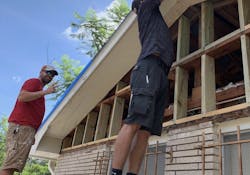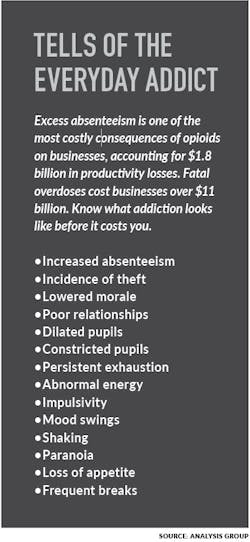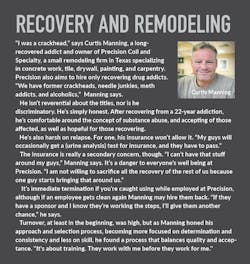At a networking dinner in Chicago a few weeks back, I struck up a conversation with an exec from a considerably sized remodeling firm. I asked him about the opioid epidemic, and if he'd seen its effects. He knew it well, he said, but wouldn't talk on record about the subject.
In the second part of our three-part series on opioids in remodeling, we introduce a young man who's struggled with opioid abuse since before he could drive. He's clean now, and the remodeling company he works for helps him remain so. We hope his story—which is not so unlike the stories of thousands of others struggling with the same addiction—will help readers better understand the complexities of substance abuse. We also hope that it will spark needed conversation in the workplace and in the industry as a whole.
Austin Donalson is 27 and a foreman at remodeling firm Precision Coil and Specialty, in Corpus Christi, Texas. He's also a recovering heroin addict. As a professional in the trades, his approach to his own addiction is rare. Remodeling doesn't finance Donalson's habit, nor has the job's demands ever triggered a relapse. Quite the opposite: Remodeling helps him stay clean.
Teenage Addict
Donalson had a stepfather, but their relationship was, generously speaking, contentious. “He’d slap me around now and then, but it wasn’t brutal. He mostly just made me feel low,” Donalson recalls.
The U.S. Department of Health has determined childhood maltreatment puts people at greater risk for developing substance abuse problems later in life. In addition, children of drug addicts are as much as eight times more likely to form an addiction than children of non-addicts, making it “one of the most potent risk factors for the development of drug disorders,” according to a Yale University School of Medicine study in which researchers interviewed hundreds of addicts and over 1,200 of their first-degree relatives (i.e., children, siblings, and parents).
“I was in seventh grade when I first tried opioids,” Donalson says. The prescription was the result of a football injury. “Even then, my mom had to hide the pills because I was taking more than I was supposed to.”
Curiosity explained the behavior at 12, but it couldn't keep explaining it. “Going into high school, I was already considered the biggest druggie in the school,” he says. At 14, Donalson was dabbling in weed, cocaine, LSD, and a wider selection of pills, though mostly Triple C—slang for Coricidin HBP, an over-the-counter cough and cold medicine.
Early experience with substance abuse, like Donalson's, is not uncommon. Nearly 700,000 kids aged 12-17 misused pain pills last year, the Substance Abuse and Mental Health Services Administration estimates. Opioid abuse at a young age is an indicator of likely future substance abuse, says Yale professor Melissa Weimer, who also heads the Addiction Medicine Consult Service for the Yale New Haven Hospital’s Program in Addiction Medicine.
“Most people I treat start at an appalling age—some are using substances by as early as nine,” Weimer says. “Whether it’s alcohol or opioids, their very susceptible brain is being flooded with neurotransmitters, putting them more at risk to develop an addiction.”
Donalson was a budding addict by his senior year of high school. “That’s the year I started to really get heavy into opioids,” he says. “My friend’s mom’s boyfriend was a hardcore addict, and of course at that age I thought he was the coolest person ever. He was just feeding us pills.”
Living On Drugs
For years, Donalson did opioids so often he didn’t realize he was addicted. “At that point, I’d never really felt [withdrawals]. I think because I never ran out.” To be high, was to be living daily life.
In hindsight, it’s so obvious. “Of course I was addicted. Of course I needed them,” he says. But at the time, it didn’t feel like a problem. “I surrounded myself with people doing exactly what I was doing. It felt normal. That was my perception of the world.”
It's not always the same path, but four in five new heroin users start out by misusing prescription painkillers, according to the Centers for Disease Control and Prevention.
If you imagine a person high on opioids, at least the way it’s traditionally portrayed, you probably picture someone noticeably sedated. The image challenges the possibility that a person could work while taking heroin. “It wasn’t like that for me,” Donalson says. “It kind of gave me a rush. If I shot up too late, I wouldn’t sleep that night.”
Working for a crew that setup lighting and audio equipment for conventions and the like—work not too dissimilar to remodeling in some ways—Donalson was never known as a user. “I would go into the restroom, get high, and come back, and they had no idea," he says. If you’re not privy to the tells of the everyday addict and the person is punctual and ostensibly professional, you’re not likely to assume something as benign as a bathroom break is an excuse to shoot heroin.
We are all in narcotics anonymous, and we'll talk about the struggles, and how other guys are doing.
It wasn’t until the drugs ran out that anyone noticed. “I spent all my money on dope and made this plan: ‘Oh, I’ll only use so much each day to hold me over until the next paycheck,’” he says, explaining how he lost his job. “I ran out before the next paycheck came and had two or three days where I had to be at work, but I just stopped showing up. At that point I was having withdrawals.”
Getting Clean
Between 40% and 60% of people with substance abuse disorders eventually relapse, according to a study in the Journal of the American Medical Association.
Donalson relapsed several times. “After I began using heroin, things got blurry," he says. “My life started to fall apart, and I dug the hole deeper and deeper. I never went back to jail, but I moved back in with my mom and for two or three years, I was in and out of rehabs, and in and out of treatments. I just couldn’t seem to get it.”
He tried a variety of treatment programs, and methadone. He went so far as to use Xanax to wean himself off heroin, but it didn't work, and the hole got deeper still. “I used to shoot dope with my kid in the back seat when he was a few months old,” Donalson confesses.
I ran out before the next paycheck came...and had to be at work, but I just stopped showing up.
The tipping point was not the rock bottom you might imagine. It was his mom smelling weed on him and telling him, “Go back to rehab or get out.” Donalson left. He went to a friend's place and over the next two weeks took "enough dope to kill a village.” When the the heroin ran out, he went back to rehab. Donalson would relapse again, but from that point forward he was in recovery.
“Looking back, that was the hardest thing for my mom to do," he says. "But it was the best thing for me.”
Staying Clean
Donalson met Curtis Manning, also a recovering addict, through Narcotics Anonymous. Manning owns Precision Coil and Specialty. He gave Donalson a job painting and hanging drywall.
Manning is a third-generation businessman who describes himself as a "recovering crackhead." He hires others in recovery because he wants to help. “I tell guys when we bring them on that the most important thing about this job, is not this job. It’s your recovery.”
Manning recalls that Donalson was a bit of a mess when he first started. “He was just like me. He’d been using so long, he didn’t know how to live clean.” Donalson needed money to pay rent, and told Manning that he wouldn’t use drugs no matter what. Manning trusted him, the way he says more remodelers should trust addicts committed to recovery.
But he does credit the job for helping him stay clean.
"The industry has been ravaged by this," Donalson says, "but this job is good for my recovery. It’s a stark reminder of where I came from, and I get to help people on a daily basis. It’s truly a blessing.”
You can hear Manning in Donalson a little bit. It speaks to Precision’s culture—this very intentional atmosphere of communication and acceptance. “We talk about recovery every day,” Manning says. “We are all in Narcotics Anonymous together, and we’ll talk about the struggles.” It’s a part of daily life at Precision—a fact of Manning’s crafting. “If they have an issue, I want them to come to me,” says Manning. “I do care.”
For recovering addicts, that policy and the encouragement to communicate about the traditionally sensitive topic of substance abuse is invaluable, because as Donalson openly admits, he’s scared of relapse. He’s scared of being in a situation, a serious injury, where he needs to take a pain pill. “It’s definitely a big fear.”
But the fear is not debilitating. Today, with more than three years clean, Donalson is strong and in a stable relationship. "I never thought that was even possible,” he says.
About the Author

James F. McClister
James McClister is managing editor for Professional Remodeler.





